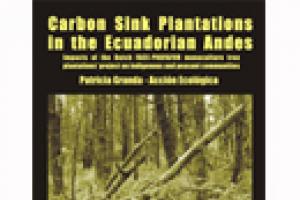From its beginnings in 1986, the World Rainforest Movement has been concerned about how forests, land and rural peoples’ lives are affected by industrial production of a whole range of commodities – soya, paper pulp, petroleum, timber, palm oil, maize, bananas, coffee and many more.
So it was only fitting that, in the mid-1990s, WRM began sounding alarms about another, brand-new export market that could also come to have severe effects on forests and the people who depend on them: the trade in biological carbon-cycling capacity.
The Green Economy
The Green Economy is a tactic used to “clean up” the image of corporations rather than address corporate capture and capitalism as the true drivers of deforestation. False solutions promoted under the Green Economy include certification, sustainable forest management, ecosystem services, REDD+, the bioeconomy, nature-based climate solutions, and zero net deforestation. Rather than stopping it, these “solutions” support corporate-driven destruction that is causing a deep social and ecological crisis.
Bulletin articles
9 December 2005
The United Nations Food and Agriculture Organization (FAO) reports outdoor field trials of GM trees worldwide in 16 countries. While the majority are located in the United States, there are also GE tree test plots in France, Germany, Britain, Spain, Portugal, Finland, Sweden, Canada, Australia, India, South Africa, Indonesia, Chile and Brazil. China is the only country known to have developed commercial plantations of GM trees, with well over one million trees planted throughout ten provinces.
Other information
9 December 2005
In 1994, the FACE Foundation signed an agreement with the Ugandan authorities to plant trees on 25,000 hectares inside Mount Elgon National Park in Uganda. FACE is working with the Uganda Wildlife Authority (UWA), which is responsible for the management of Uganda's National Parks.
The FACE Foundation (Forests Absorbing Carbon dioxide Emissions) was set up in 1990 by the Dutch electricity generating board with the aim of planting trees to absorb and store carbon, supposedly to compensate for the greenhouse gas emissions from a new power station to be built in the Netherlands.
Other information
12 October 2005
As it has been already informed, the Forest Stewardship Council (FSC) has started the Plantations Review process (See WRM Bulletin 92).
Several organizations, WRM among them, that since long time ago have been requesting the FSC to review the certification of plantations, have supported the process with documentation and research on the negative social and environmental impacts of those monoculture large scale tree plantations.
Bulletin articles
12 October 2005
Japan’s biggest paper manufacturer, Nippon Paper (NP) is known as an industry leader in environmental reform, but how real is this?
South East Fibre Exports at Eden, about 500 kms south of Sydney, is a NP subsidiary.
It is Australia’s oldest chipmill and was the first overseas operation of the former Daishowa Paper Manufacturing Company (taken over by NP a couple of years ago).
Publications
2 May 2005
Impacts of the Dutch FACE-PROFAFOR monoculture tree plantations' project on indigenous and peasant communities
By Patricia Granda. Joint Research of Acción Ecológica and WRM
Carbon Sink Plantations in the Ecuadorian Andes
Other information
20 April 2005
In 1998, the World Bank and WWF announced a new ‘Forest Alliance’ with the target of securing 200 million hectares of certified forests in World Bank client countries by 2005. The Alliance has faced a serious challenge in reaching this goal.
Other information
20 April 2005
The concept of carbon trading as an instrument to ‘avert dangerous climate change’ first surfaced in the negotiations that resulted in the UN Framework Convention on Climate Change (UNFCCC) of 1992. Under the UNFCCC, projects claiming to reduce greenhouse gas emissions could sell the ‘saved’ emissions to a company that finds it more lucrative to pay someone else to reduce emissions rather than to reduce them themselves.
Bulletin articles
21 March 2005
The Forest Stewardship Council's Plantations Review is finally under way. The 12 member committee elected to implement the first part of this process (the “policy phase”) held its first meeting from 9-11 March in Stockholm, Sweden. Four members –two northern and two southern- from each of the three chambers (social, environmental and economic), will have the task of leading this process and elaborating clear guidelines for future certification of plantations. A possible second “technical phase” is now being discussed by the committee members.
Bulletin articles
21 March 2005
On 18 October 2004, Samling Plywood, the Malaysian timber corporation, was granted a Certificate for Forest Management under the Malaysian Timber Certification Council (MTCC) for the alleged sustainable logging of one of Sarawak's last remaining contiguous areas of primary rainforest.
Other information
21 March 2005
For the second time, the Clean Development Mechanism's (CDM) Executive Board has rejected the reasons of Vallourec & Mannesmann do Brasil for requesting carbon credit money for industrial tree plantations.
Other information
21 March 2005
In early March 2005, the first carbon sinks project promoted by the World Bank's BioCarbonFund entered the first stage of registering as a CDM project under the Kyoto Protocol. Around the same time, a template document for BioCarbonFund sinks project developers to estimate sequestration rates was posted on the World Bank carbon finance website. The template used some slightly irreverent examples to illustrate how to fill in certain fields. The highlight was in the section “Contact (preferably email)” which was filled in “ fred@data_fiddling_Inc.jail.com ”.

